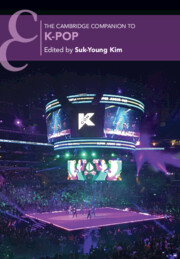Book contents
- The Cambridge Companion to K-Pop
- Cambridge Companions to Music
- The Cambridge Companion to K-Pop
- Copyright page
- Contents
- Figures
- Tables
- Contributors
- Acknowledgments
- Notes to Readers
- Introduction
- Part I Genealogies
- Part II Sounding Out K-Pop
- 3 Finding the K in K-Pop Musically
- 4 Recording the Soundscape of K-Pop
- Part III Dancing to K-Pop
- Part IV The Making of Idols
- Part V The Band That Surprised the World
- Part VI Circuits of K-Pop Flow
- Index
4 - Recording the Soundscape of K-Pop
from Part II - Sounding Out K-Pop
Published online by Cambridge University Press: 02 March 2023
- The Cambridge Companion to K-Pop
- Cambridge Companions to Music
- The Cambridge Companion to K-Pop
- Copyright page
- Contents
- Figures
- Tables
- Contributors
- Acknowledgments
- Notes to Readers
- Introduction
- Part I Genealogies
- Part II Sounding Out K-Pop
- 3 Finding the K in K-Pop Musically
- 4 Recording the Soundscape of K-Pop
- Part III Dancing to K-Pop
- Part IV The Making of Idols
- Part V The Band That Surprised the World
- Part VI Circuits of K-Pop Flow
- Index
Summary
The invention of the MP3 and its distribution on the internet affected the South Korean music industry in multifarious ways, instigating a sharp decrease in CD sales but also contributing to K-pop’s shift from audio to visual culture. Because many scholars contend that K-pop is driven by the visual, academic analysis has been dominated by discussions of visual aesthetics; other aspects of K-pop, especially its use of acoustic techniques and vocalization, have largely been neglected. Drawing on R. Murray Schafer’s definition of “soundscape” – where sound is the combination of layers of culture, place, acoustic space, and technology – this chapter provides an overview of K-pop’s soundscapes over the past thirty years. The industry has responded to new recording technologies and new media, which are linked to specific aspects of South Korean time and space. The mediation of sound in studio recording booths, where K-pop singers give literal voice to their self-expression, has become an integral component of the sonic form. In addition to the vocal styles of K-pop artists, the chapter addresses the auditory practices of recording artists ranging from singer-songwriters to K-pop boy bands as well as the interventions of sound engineers and producers in the recording process.
- Type
- Chapter
- Information
- The Cambridge Companion to K-Pop , pp. 73 - 94Publisher: Cambridge University PressPrint publication year: 2023



